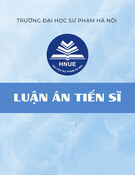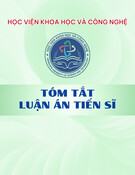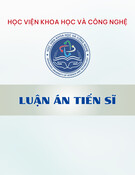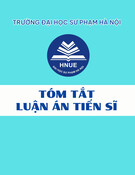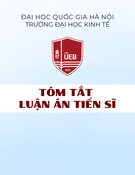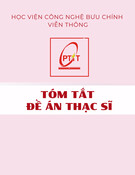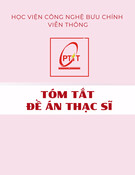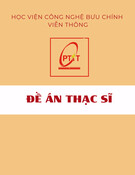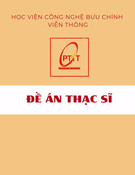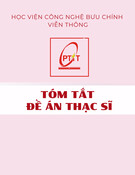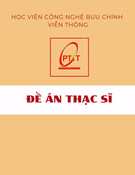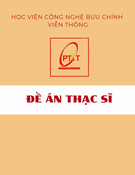
MINISTRY OF EDUCATION
AND TRAINING
VIETNAM ACADEMY
OF SCIENCE AND TECHNOLOGY
GRADUATE UNIVERSITY SCIENCE AND TECHNOLOGY
----------------------------
Hoang Kim Chi
STUDY ON RHIZOSPHERE MICROBIAL COMMUNITIES OF
MEDICINAL PLANT Curcuma longa L. TO ENHANCE TURMERIC
YIELD AND QUALITY
Major: Microbiology
Code: 9 42 01 07
SUMMARY OF DOCTORAL THESIS
Hanoi - 2020

The thesis was accomplished at: Graduate University of Science and
Technology, Vietnam Academy of Science and Technology.
First supervisor: Prof. Dr. Le Mai Huong
Second supervisor: Dr. Tran Thi Nhu Hang
First reviewer:
Second reviewer:
Third reviewer:
The thesis defence will be held on …………….……………….. at
Graduate University of Science and Technology, Vietnam Academy of
Science and Technology.
The thesis will be documented at:
- Library of Graduate University of Science and Technology
- National Library of Vietnam

1
INTRODUCTION
1. Relevance of the research topic
Curcuminoids are main bioactive ingredients of turmeric
Curcuma longa L.. As a result of the recent growing demand for
these compounds for pharmaceutical industrial application, the
development of high quality turmeric production has become an
urgent issue. To solve the problem, amendments in agricultural
practices, post-harvesting processing techniques, and
biotechnological methods have been highlighted.
From another perspective, reducing chemical fertilizer while
remaining crop yield is a trend of modern environmental friendly
agronomy these years. Developing microbial inoculations from
effective microorganisms for particular agricultural plants has thus
been considered a practical focus. On the other hand, several
rhizosphere soil microorganisms have been reported to play
important roles in promoting biosynthesis of secondary metabolites,
including curcuminoids. The entitled “Study on rhizosphere
microbial communities of medicinal plant Curcuma longa L. to
enhance turmeric yield and quality” was conducted to apply
microbiology in sustainable development of agricultural productivity
in Vietnam and worldwide.
2. Thesis objectives
The purpose of this thesis was to exploit beneficial aspects of
microbial rhizosphere communities, especially effective bacteria and
fungi of turmeric plant C. longa. The results were expected to

2
support fundamental documents for proposing a suitable integrated
nutrient management for turmeric plant in Vietnam.
3. Thesis contents
Major contents of the research include: (i) Study on the
relationship between varied nitrogen fertilizing managements and
turmeric productivity; (ii) Isolation and biological assessments of
rhizobacteria and fungi from turmeric plant; (iii) Study on genetic
diversity of turmeric rhizosphere microbiomes in relation to high
productivity nitrogen fertilizing managements; (iv) Preparation of
biofertilizer from selected turmeric rhizosphere microbial candidates
and case study in turmeric plant.
CHAPTER 1. OVERVIEW
1.1. Turmeric Curcuma longa L. and curcuminoids component
Turmeric (Curcuma longa L.) is a medicinal plant of family
Zingiberaceae that distributes widely in South- and Southeast Asia,
most abundantly in India and Thailand, and followed by Bangladesh,
Indonesia, Myanmar and Vietnam [38] [39].
Chemical composition
The rhizome of turmeric C. longa was determined to
compose of 6,3-7% protein, 5,1-7,5% fat, 3,5-5% minerals, 69,4%
carbohydrate and 9,5-13,1% water [43]. Major bioactive components
of turmeric rhizome comprise curcuminoids [including curcumin,
demethoxycurcumin (DMC) and bisdemethoxycurcumin (BDMC)],
aromatic turmerone (ar-turmerone), α-turmerone and β-turmerone.
Commercialized curcumin mix was known to composed of 77% pure
(Cur), 17% DMC and 3% BDMC [44]. According to Naama et al.

3
(2013), curcumin and DMC are less stable than BDMC [45]. In
terms of antioxidant and tumor inhibiting active intensities, curcumin
was considered the most potent, followed by DMC and BDMC,
respectively [46] [44].
Biological and pharmaceutical activities of curcuminoids from
turmeric
The biological and pharmaceutical activities of turmeric and
curcuminoids in particular have been well studied. As estimation
until 2011, more than 7000 published articles have shed light on
various aspects of curcumin including its antioxidant, hypoglycemic,
anti-inflammatory and anti-cancer activities. Also, this natural
compound exerts its beneficial effects by modulating different
signaling molecules including transcription factors, chemokines,
cytokines, tumor suppressor genes, adhesion molecules, microRNAs,
etc. [47].
1.2. Turmeric rhizosphere associated microorganisms
Rhizosphere is defined as the area around a plant root that is
inhabited by a unique population of microorganisms influenced by
the chemicals released from plant roots [70, 71, 72]. The special
conditions shape rhizosphere a desirable niche for microbial
communities and one of the most biodiverse and dynamic habitat on
the earth.
Rhizosphere microorganisms have received attention since
the intimate plant-microbe relationship being mentioned and
evidenced. About 2–5% of rhizosphere microorganisms have been
known to positively affect plant growth, and plants in turn are able to
control these beneficial microorganisms [73, 74]. Accordingly, the
rhizosphere microbiome plays an important role in improving soil
fertility, plant metabolisms and ultimately enhancing plant

